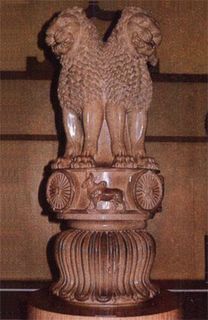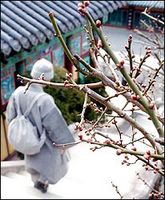Một cuộc hành hương
Viết bởi ky' giả Joanne Hammer
 Một vị Tăng sĩ người dân bản xứ Crawfordsville sẽ bắt đầu một cuộc hành hương đi bộ năm tháng bắt đầu vào tuần tới.Jotipal Bhikkhu, sanh tại Crawfordsville , sẽ bắt đầu khởi hành cuộc hành tri`nh đi bộ vào ngày 1 tháng Ba từ New Orleans, Louisiana, và chấm dứt tại Thunder Bay, Ontario, Canada. Cùng đi trong chuyến viễn du này với Ty` Khưu Jotipal là Austin Stewart người Gunnison, Colorado.Ông hy vọng thực tập đời sống trong đức tin, sự sinh tồn trên giảm thiểu và thể hiện sự hoà thuận trong mỗi cá nhân.Jotipalo, người đã là Phật tử 12 năm và trở thành tu sĩ 5 năm, đã coi Tu Viện abhayagiri Buđdhist Monastery tại thung lũng Redwơod, California như là Tu Viện nhà của ông ta. Tu Viện là chi nhánh với phái Lâm Tăng Thái Lan và truyền thống Theravada. Trong truyền thống, nó bi`nh thường cho những vị Tăng và Ni đi hành hương. Ông ta nói như thế.Vị Tu sĩ nói rằng : "Đi bộ là tiếp tục một sự thực tập với tầm quan trọng trong cuộc sống dễ dàng, thiền định và tùy thuộc trên sự tử tế và sự rộng lượng của những người mong muốn trông thấy chúng tôi thành công."Jotipal, 39 tuổi, năm 1984 ông tốt nghiệp trung học Crawfordsville và năm 1988 ông tốt nghiệp đại học Wabash College, là nơi ông học về hội hoạ và khoa cổ điển. Ông dọn tới New York làm việc như một người hoạ sĩ, nhưng bắt đầu làm việc lại là người bán hàng cho Norcote Interational.Cuộc hành hương của vị tu sĩ này bắt đầu sau một lần súyt chết trong một lần tại núi Hi Mã Lạp Sơn tại Nepal. Trong ba ngày ông đã bịnh rất nặng và đã trải qua không biết thân thể ông ra sao, đó là ly' do làm cho ông nhận ra rằng sự hiện hữu của thân tứ đại thật sự không quan trọng.Ông bắt đầu tập yoga và thiền định, dần dần ông ti`m hiểu thêm về đạo Phật. Ông cũng đọc về một người đàn bà đi hành hương cho hoà bi`nh, người từ năm 1953 tới năm 1981 đi bộ trên 25,000 miles, đã chia sẻ nội tâm và thế giới hoà bi`nh."Nó thật sự đã thổi tôi đi thật xa" Ty` Khưu Jotipalo nói "Nó đã là một sự thức tỉnh tinh thần của cá nhân an lạc có thể ảnh hưởng tới cộng đồng và lan rộng tới thế giới hoà bi`nh."Ty` Khưu Jotipalo thi` không chắc chắn cái gi` sẽ xảy ra trong lộ tri`nh 1,800 dọc theo quốc lộ 61.Mặc dù ông có một vài vật thuộc quyền sở hữu, ông sẽ mang theo ba bộ casa, một túi trong đó có một cái dù có và một tấm bạt dài rộng 10 square . Ông ta không được giữ tiền, Stewart sẽ mua thực phẩm trong suốt thời gian hành tri`nh. Họ hy vọng sẽ đi qua những con đường tại các thị trấn nhỏ dọc theo bờ sông, làm sao cho có thăng bằng trong sự tiếp xúc với công chúng và sự cô đọng trong thiền địnhHai người dự trù đi bộ khoảng 20 miles một ngày, bắt đầu từ New Orleans đi xuyên qua Mimphis, Tennessee, St. Louis, Missouri, Dubuque, Iowa, Minneapolis, Minnesota, và cuối cùng tại Arrow River Forest Hermitage tại Thunder BAy, Ontario vào ngày 20 tháng 8.Để theo dõi chuyến hành hương của Ty` khưu Jotipalo, xin va`o http://www.abhayagiri.org.
Một vị Tăng sĩ người dân bản xứ Crawfordsville sẽ bắt đầu một cuộc hành hương đi bộ năm tháng bắt đầu vào tuần tới.Jotipal Bhikkhu, sanh tại Crawfordsville , sẽ bắt đầu khởi hành cuộc hành tri`nh đi bộ vào ngày 1 tháng Ba từ New Orleans, Louisiana, và chấm dứt tại Thunder Bay, Ontario, Canada. Cùng đi trong chuyến viễn du này với Ty` Khưu Jotipal là Austin Stewart người Gunnison, Colorado.Ông hy vọng thực tập đời sống trong đức tin, sự sinh tồn trên giảm thiểu và thể hiện sự hoà thuận trong mỗi cá nhân.Jotipalo, người đã là Phật tử 12 năm và trở thành tu sĩ 5 năm, đã coi Tu Viện abhayagiri Buđdhist Monastery tại thung lũng Redwơod, California như là Tu Viện nhà của ông ta. Tu Viện là chi nhánh với phái Lâm Tăng Thái Lan và truyền thống Theravada. Trong truyền thống, nó bi`nh thường cho những vị Tăng và Ni đi hành hương. Ông ta nói như thế.Vị Tu sĩ nói rằng : "Đi bộ là tiếp tục một sự thực tập với tầm quan trọng trong cuộc sống dễ dàng, thiền định và tùy thuộc trên sự tử tế và sự rộng lượng của những người mong muốn trông thấy chúng tôi thành công."Jotipal, 39 tuổi, năm 1984 ông tốt nghiệp trung học Crawfordsville và năm 1988 ông tốt nghiệp đại học Wabash College, là nơi ông học về hội hoạ và khoa cổ điển. Ông dọn tới New York làm việc như một người hoạ sĩ, nhưng bắt đầu làm việc lại là người bán hàng cho Norcote Interational.Cuộc hành hương của vị tu sĩ này bắt đầu sau một lần súyt chết trong một lần tại núi Hi Mã Lạp Sơn tại Nepal. Trong ba ngày ông đã bịnh rất nặng và đã trải qua không biết thân thể ông ra sao, đó là ly' do làm cho ông nhận ra rằng sự hiện hữu của thân tứ đại thật sự không quan trọng.Ông bắt đầu tập yoga và thiền định, dần dần ông ti`m hiểu thêm về đạo Phật. Ông cũng đọc về một người đàn bà đi hành hương cho hoà bi`nh, người từ năm 1953 tới năm 1981 đi bộ trên 25,000 miles, đã chia sẻ nội tâm và thế giới hoà bi`nh."Nó thật sự đã thổi tôi đi thật xa" Ty` Khưu Jotipalo nói "Nó đã là một sự thức tỉnh tinh thần của cá nhân an lạc có thể ảnh hưởng tới cộng đồng và lan rộng tới thế giới hoà bi`nh."Ty` Khưu Jotipalo thi` không chắc chắn cái gi` sẽ xảy ra trong lộ tri`nh 1,800 dọc theo quốc lộ 61.Mặc dù ông có một vài vật thuộc quyền sở hữu, ông sẽ mang theo ba bộ casa, một túi trong đó có một cái dù có và một tấm bạt dài rộng 10 square . Ông ta không được giữ tiền, Stewart sẽ mua thực phẩm trong suốt thời gian hành tri`nh. Họ hy vọng sẽ đi qua những con đường tại các thị trấn nhỏ dọc theo bờ sông, làm sao cho có thăng bằng trong sự tiếp xúc với công chúng và sự cô đọng trong thiền địnhHai người dự trù đi bộ khoảng 20 miles một ngày, bắt đầu từ New Orleans đi xuyên qua Mimphis, Tennessee, St. Louis, Missouri, Dubuque, Iowa, Minneapolis, Minnesota, và cuối cùng tại Arrow River Forest Hermitage tại Thunder BAy, Ontario vào ngày 20 tháng 8.Để theo dõi chuyến hành hương của Ty` khưu Jotipalo, xin va`o http://www.abhayagiri.org.(Bản dịch: Minh Hạnh)
A spiritual and literal journey
By Joanne Hammerjhammer@jrpress.com
A Buddhist monk with native origins in Crawfordsville will begin a five-month pilgrimage walk next week.
Jotipalo Bhikkhu, born in Crawfordsville as Don Sperry, will begin the walk March 1 in New Orleans, La., and end in Thunder Bay, Ontario, Canada. Traveling with him will be layperson Austin Stewart, Gunnison, Colo.
His hope is to practice living on faith, surviving on less and showing peace to individuals.
Jotipalo, who has been a Buddhist for about 12 years and a monk for five years, considers Abhayagiri Buddhist Monastery in Redwood Valley, Calif., his home monastery. The monastery is affiliated with the Thai Forest and Theravada Buddhist traditions. In the tradition, it is common for monks and nuns to undertake pilgrimages, he said.
“This walk is a continuation of that practice with an emphasis on living simply, meditation and dependence on the kindness and generosity of those that wish to see us succeed,” he said.
Jotipalo, 39, is a 1984 Crawfordsville High School graduate and 1988 Wabash College graduate, where he studied art and the classics. He moved to New York to work as an artist, but began working as a salesperson for Norcote International.
His spiritual journey began after a near-death experience in the Himalayas in Nepal. For three days he was extremely ill and had an out-of-body experience, which caused him to realize the unimportance of material possessions, he said.
He began practicing yoga and meditation, gradually learning more about Buddhism. He also read about a woman named Peace Pilgrim, who from 1953-1981 walked more than 25,000 miles, sharing messages of inner and world peace.
“It totally blew me away,” Jotipalo said. “It was a spiritual awakening of how individual peace can affect the community and keep expanding to world peace.”
Jotipalo is uncertain as to what to expect in the 1,800 mile journey along U.S. 61.
Although he has few possessions, he will wear three robes, carry a backpack that holds a tent shaped like a large umbrella with netting and a 10-square-foot tarp. Since he cannot handle money, Stewart will buy food during the trip. They hope to travel small county roads along a river and balance public interaction with solitude and meditation.
The two plan to walk about 20 miles a day, traveling from New Orleans through Memphis, Tenn., St. Louis, Mo., Dubuque, Iowa, Minneapolis, Minn., and end at Arrow River Forest Hermitage in Thunder Bay, Ontario, by Aug. 20.
For future updates on Jotipalo’s walk, visit http://www.abhayagiri.org.
http://feeds.bignewsnetwork.com/redir.php?jid=0d86849da7d164b1&cat=f97ff7b11934dbb6



